Abstract
This study investigated the effects of exposure of diabetic rats to electromagnetic radiation (EMR) of 900 MHz from cell phone base stations antenna for four weeks on plasma triglycerides and cholesterol. We also examined whether selenium administration into these rats affects the levels of these parameters. Our results showed that the exposure of diabetic rats to this EMR increased the plasma triglycerides, total cholesterol and VLDL-c. The daily intraperitoneally injection of 2.0 µg selenium/kg body weight as sodium selenite into these rats decreased the triglycerides and VLDL-c levels compared to diabetic rats with EMR exposure. Selenium also restored the normal levels of plasma triglycerides, total cholesterol and HDL-c as compared to control rats. In conclusion, selenium decreased the elevated levels of triglycerides and cholesterol in diabetic rats exposed to EMR from cell phone base stations and hence it may decrease the development of some diabetic complications.
1. Introduction
Cell phones and their base stations emit low levels of the electromagnetic radiation (EMR) even in the stand-by mode [Citation1]. The number of cell phones subscriptions had reached several billion and the number of users of cell phones is continuously increasing [Citation2]. Heavy users of cell phones suffer from some health signs such as weakness, stress, headache and sleep disturbance [Citation3]. The exposure of tissues and organs to this EMR induces some modifications at the cellular and molecular levels. The severity of these effects depends on the duration of exposure to the EMR and the extent of tissue penetration [Citation4]. There are several hundred million patients with type 2 diabetes mellitus (T2DM) around the world. Type 2 diabetes mellitus is accompanied with dyslipidemia resulting from the increased plasma levels of total cholesterol. The dyslipidemia includes increased levels of low-density lipoprotein in cholesterol (LDL-c), very low-density lipoprotein cholesterol (VLDL-c) and triglycerides levels as well as the decreased high-density lipoprotein cholesterol (HDL-c) [Citation5–7]. The exposure of healthy animals to EMR influenced serum triglyceride and cholesterol levels [Citation8]. It is important to understand the effects of exposure of T2DM patients to EMR on the serum lipids and on the development of diabetic complications such as atherosclerosis and heart disease.
Selenium is an essential trace element in human and animals and it occurs in selenoproteins in the form of the amino acid selenocysteine [Citation9]. It may mimic insulin activity in experimental diabetic models [Citation10]. The daily supplementation of selenium to patients with polycystic ovary syndrome for eight weeks decreased the levels of triglycerides and VLDL-c [Citation11]. Selenium has some beneficial effects in human health such as decreasing the risk of development of atherosclerosis [Citation12].
This study investigated the effects of exposing diabetic rats to EMR, at 900 MHz for 24 h/day for four weeks, on the levels of plasma triglycerides and cholesterol. The current study also examined the effects of treatment of these rats with selenium on the levels of triglycerides and cholesterol.
2. Materials and Methods
2.1. Preparation of diabetic rats
Male Sprague–Dawley rats (180–220 g) were obtained from the animal facility at the Beirut Arab University (BAU), Beirut, Lebanon. All animal care and procedures were carried out according to the NIH guidelines and the study proposal was approved by the IRB committee of the Beirut Arab University, Lebanon. Animals were maintained at 20–25°C with 12 h light/dark cycle and food and water were ad libitum.
To establish T2DM model, rats received intraperitoneal (i.p.) injected with 55 mg of streptozotocin/kg body weight dissolved in citrate buffer (pH 4.5) after i.p. injection of 120 mg of nicotinamide/kg body weight dissolved in saline [Citation13,Citation14]. Rats with a blood glucose level higher than 200 mg/dl after 48 h of streptozotocin/nicotinamide administration were considered as diabetic rats.
2.2. EMR exposure
Groups of normal and diabetic rats were continuously exposed to EMR emitted from a GSM mobile phone antenna (900 MHz, Eeff=25 V/m) during the 24 h/day for four weeks. During the EMR exposure, each rat was able to move freely in a plastic cage, without any metallic fittings.
2.3. Animal groups
A number of 42 male rats were divided into seven groups (6 animals in each group). 1) C: control rats. 2) T2DM: diabetic rats. 3) EMR: rats exposed to EMR as indicated above. 4) T2DM + EMR group. 5) EMR + Se: normal rats exposed to EMR and treated with a daily i.p. injection of 0.73 µg selenium/kg body weight as sodium selenite. 6) T2DM + EMR+ daily i.p. injection of 0.73 µg selenium/kg body weight. 7) T2DM + EMR+ daily i.p. injection of 2.0 µg selenium/kg body weight. Animals from all groups were weighed on a daily basis. After four weeks of EMR exposure, all rats were euthanized by CO2 inhalation and blood samples were withdrawn from the right ventricle of the heart. Plasma was separated, frozen in liquid nitrogen and stored at −80°C for biochemical analysis.
2.4. Determination of cholesterol and triglycerides levels
Plasma levels of triglycerides, total cholesterol, HDL-c and LDL-c were determined using commercial kits (Analyticon biotechnologies, Germany) according to the vender protocols [Citation15,Citation16]. VLDL-c level was calculated by the Friedewald equation [Citation17] where VLDL-c = TG/5.
2.5. Statistical analysis
Statistical differences between treated and control rats were analyzed by one-way analysis of variance (ANOVA) using SPSS 20.0 software followed by Post-hoc testing with least significance difference (LSD). All values were expressed as the mean ± standard error of the mean (SEM) for six rats in each group. A significant difference was considered at p< 0.05.
3. Results
3.1. Effects of treatments on plasma triglycerides
The plasma level of triglycerides was increased in T2DM rats by seven folds (236.2 ± 46.5 mg/dl) compared to the control group (31.7 ± 5.0 mg/dl) and by two folds as compared to the EMR group (115.1 ± 19.3 mg/dl) at p < 0.05 (Table , Figure ). The exposure of diabetic rats to EMR for four weeks increased the plasma triglycerides by five folds (176.9 ± 54.1 mg/dl) compared to that in the control rats (p = 0.005). There was no significant change in plasma triglycerides in the diabetic rats exposed to EMR when compared to the T2DM group (p = 0.222) or the EMR group (p = 0.204).
Figure 1. Effects of EMR exposure and selenium administration into normal and diabetic rats on plasma triglycerides (mg/dl). Data are presented as mean ± SEM for six rats in each group. Significant difference at p<0.05 when compared to *control group, † EMR group, # diabetic group or ‡ T2DM+ EMR group.
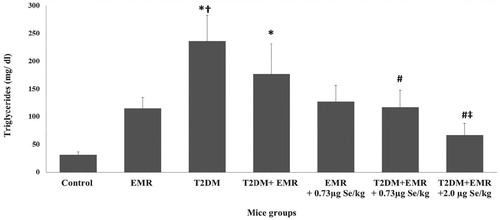
Table 1. Plasma Triglycerides and total cholesterol levels (mg/dl) in different groups of animals.
Treatment of the T2DM + EMR group for four weeks with 2.0 µg Se/kg body weight decreased the triglycerides (66.6 ± 20.6 mg/dl) compared to the T2DM and T2DM + EMR groups (p = 0.003 and 0.047, respectively). Both doses of selenium reduced the plasma triglycerides to levels similar to those in the control rats (p = 0.081 and 0.516, respectively).
3.2. Effects of treatments on plasma cholesterol
The plasma levels of total cholesterol were increased in the T2DM rats (91.2 ± 6.8 mg/dl) and in the T2DM + EMR group (86.1 ± 11.2 mg/dl) compared to the control rats (49.6 ± 6.1 mg/dl) at p = 0.002 and 0.006, respectively (Table , Figure ). Treatment of the T2DM + EMR group with 2.0 µg Se/kg body weight decreased the total cholesterol to 63.8 ± 5.0 mg/dl which was similar to that in the control rats (p = 0.312).
Figure 2. Effects of EMR exposure and selenium administration in different groups of normal and diabetic rats on plasma total cholesterol (mg/dl). Data are presented as mean ± SEM for six rats in each group. Significant difference at p<0.05 when compared to *control group, † EMR group or # diabetic group.

There was no significant difference in plasma LDL-c, HDL-c or LDL-c/HDL-c ratio in T2DM and T2DM+ EMR groups compared to the control rats (Figures and ). Treatment of the T2DM + EMR group with 0.73 µg Se/kg body weight increased the plasma level of HDL-c (53.4 ± 6.3 mg/dl) compared to the control rats (28.2 ± 5.4 mg/dl) at p = 0.043 (Figure ). Both doses of selenium decreased the LDL-c/HDL-c ratio in the T2DM + EMR group to levels like those in the control rats (p = 0.219 and 0.335 respectively) (Figure ).
Figure 3. Effects of EMR exposure and selenium administration in different groups of normal and diabetic rats on plasma HDL-c (mg/dl). Data are presented as mean ± SEM for six rats in each group. Significant difference at p<0.05 when compared to * control group or # diabetic group.
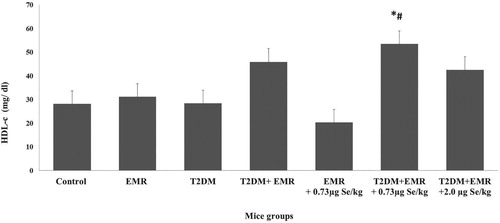
Figure 4. Effects of EMR exposure and selenium administration in different groups of normal and diabetic rats on plasma LDL-c (mg/dl). Data are presented as mean ± SEM for six rats in each group. Significant difference at p<0.05 when compared to *control group, † EMR group or # diabetic group.
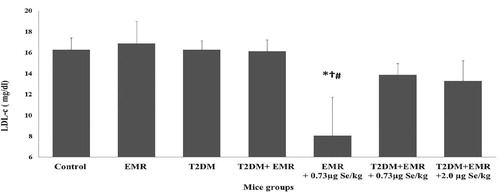
Figure 5. Effects of EMR exposure and selenium administration in different groups of normal and diabetic rats on LDL-c/HDL-c ratio. Data are presented as mean ± SEM for six rats in each group. Significant difference at p<0.05 when compared to † EMR group or # diabetic group.
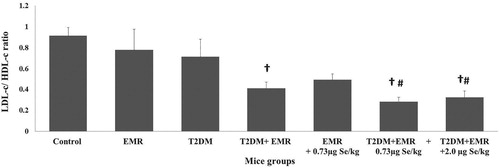
The plasma levels of VLDL-c were elevated in the T2DM group by seven folds (47.2 ± 9.3 mg/dl) and in the T2DM + EMR group by five folds (35.3 ± 10.8 mg/dl) compared to control rats (6.3 ± 1.0 mg/dl), at p < 0.05 (Figure ). Selenium administration at the dose of 2.0 µg Se/kg body weight into the T2DM + EMR group decreased the VLDL-c level (13.3 ± 84.1 mg/dl) compared to the untreated T2DM + EMR group (p = 0.047).
Figure 6. Effects of EMR exposure and selenium administration in different groups of normal and diabetic rats on plasma VLDL-c (mg/dl). Data are presented as mean ± SEM for six rats in each group. Significant difference at p<0.05 when compared to *control group, † EMR group, # diabetic group or ‡ T2DM+ EMR group.
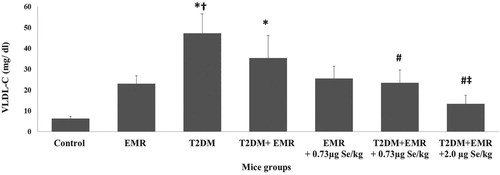
4. Discussion
Nowadays, the cell phone telecommunication is spreading and the numbers of cell phones users are continuously growing. There is an increased concern about the effects of heavy exposure to the emitted EMR from cell phones and their base stations on human health [Citation18]. Type 2 diabetes mellitus is also a global health problem affecting more than 450 million patients around the world [Citation19]. The prevalence of diabetes is expected to increase dramatically by the year 2030 [Citation20]. Atherosclerosis and coronary heart disease are diabetic complications resulting from decreased levels of blood HDL-c and elevated levels of LDL-c and triglycerides [Citation21].
The current study investigated the effects of exposing diabetic rats to electromagnetic radiation of 900 MHz for 24 h/day for 4 weeks on the plasma triglycerides and total cholesterol. Our data show that the exposure of normal rats to this EMR had no significant effect on the plasma triglycerides and cholesterol levels, compared to control rats. The exposure of male NMRI strain of mice to EMR of 1800MHz also showed no effect on serum triglycerides and total cholesterol [Citation22]. Treatment of prenatal and postanal rats to EMR at 900 MHz for 30 min/day for 80 days had not affected the levels of plasma total cholesterol [Citation23]. However, the exposure of Syrian hamsters to EMR at 900 MHz for 1 h/for 10 or 50 days decreased the levels of plasma triglycerides and total cholesterol [Citation24].
Our results showed that the exposure of T2DM rats to EMR of 900 MHz increased the plasma levels of total cholesterol, VLDL-c and triglycerides but not HDL-c or LDL-c, as compared to control rats. The increased levels of plasma total cholesterol and triglycerides were likely resulting from the increased levels of VLDL-c. It has been previously shown that EMR exposure affects the activities of fatty acid synthase and HMG-CoA reductase which are the key enzymes in the pathways of fatty acid and cholesterol biosynthesis. In addition, the increased triglycerides levels after the EMR exposure may also result from the decreased activity of lipoprotein lipase that hydrolyses triglycerides in chylomicrons [Citation25]. Therefore, the exposure of T2DM rats to this EMR may result in dyslipidemia that increases the risk of development of some diabetic complications such as atherosclerosis and cardiovascular diseases.
Selenium administration into the T2DM + EMR rats decreased the plasma levels of triglycerides and VLDL-c compared to the T2DM + EMR rats. It restored the normal levels of the plasma HDL-c, total cholesterol, VLDL-c and triglycerides, as compared to the control rats. A previous study also reported that selenium supplementation of rabbits for twelve weeks decreased the levels of triglycerides and cholesterol and increased the level of HDL-c [Citation26]. Selenium in combination with vitamin E decreased the total cholesterol level by increasing its elimination from tissues such as smooth muscle cells and facilitating its transport into the liver. Thus selenium may prevent the deposition and formation of atherosclerotic plaques [Citation26]. Selenium administration into Sprague- Dawley rats fed high-fat diet (HFD) for three months reduced the levels of triglycerides and total cholesterol, compared to rats fed with HFD [Citation27]. On the other hand, feeding rats with Se- deficient diet increased the plasma levels of total cholesterol and LDL-c and decreased the HDL-c level. It down regulated the LDL-receptors that bind to LDL-c from the blood [Citation28–30]. Spontaneously hypertensive (SHR) rats fed Se-deficient diet had higher plasma levels of triglycerides, total cholesterol and VLDL-c than SHR rats fed Se-sufficient diet. Selenium deficiency decreased fatty acid oxidation and increased fatty acid esterification resulting in accumulation of VLDL-c and cholesterol esters in the blood [Citation31]. It has been shown that selenium supplementation decreased hypercholesterolemia by increasing paraoxonase 1 activity. This enzyme catalyzes the hydrolysis of oxidized phospholipids and thus it can protect LDL-c, HDL-c and membranes from oxidative modifications [Citation32].
In conclusion, the exposure of diabetic rats to EMR from cell phones or their base stations increased the plasma levels of triglycerides, VLDL-c and total cholesterol. Selenium administration into these rats increased the plasma levels of HDL-c and reduced the increased levels of triglycerides, total cholesterol and VLDL-c to levels similar to those in control rats. Therefore, selenium supplementation of T2DM patients who have excessive exposure to EMR can minimize the hypertriglyceridemia and hypercholesterolemia. Further investigation is required to understand the molecular mechanisms by which selenium increases the level of plasma HDL-c and decreases the levels of total cholesterol and triglycerides in diabetic rats exposed to excessive EMR of 900 MHz.
Declaration of interest
No conflict of interest was declared by the authors.
Disclosure statement
No potential conflict of interest was reported by the authors.
ORCID
Mohamed E. Moustafa http://orcid.org/0000-0003-1308-6221
References
- Mortazavi SAR, Tavakkoli-Golpayegani A, Haghani M, et al. Looking at the other side of the coin: the search for possible biopositive cognitive effects of the exposure to 900 MHz GSM mobile phone radiofrequency radiation. Journal of Environmental Health Science and Engineering. 2014;12(1):75. doi: 10.1186/2052-336X-12-75
- Ni S, Yu Y, Zhang Y, et al. Study of oxidative stress in human lens epithelial cells exposed to 1.8 GHz radiofrequency fields. PloS one. 2013;8(8):e72370. doi: 10.1371/journal.pone.0072370
- Söderqvist F, Carlberg M, Hardell L. Use of wireless telephones and self-reported health symptoms: a population-based study among Swedish adolescents aged 15–19 years. Environ Health. 2008;7(1):18. doi: 10.1186/1476-069X-7-18
- Levitt BB, Lai H. Biological effects from exposure to electromagnetic radiation emitted by cell tower base stations and other antenna arrays. Environ Rev. 2010;18(NA):369–395. doi: 10.1139/A10-018
- Association AD. Diagnosis and classification of diabetes mellitus. Diabetes Care. 2010;33(Supplement 1):S62–SS9. doi: 10.2337/dc10-S062
- Dullaart RP, de Vries R, Lefrandt JD. Increased large VLDL and small LDL particles are related to lower bilirubin in type 2 diabetes mellitus. Clin Biochem. 2014;47(16-17):170–175. doi: 10.1016/j.clinbiochem.2014.08.008
- Nassar PO, Walker CS, Salvador CS, et al. Lipid profile of people with diabetes mellitus type 2 and periodontal disease. Diabetes Res Clin Pract. 2012;96(1):35–39. doi: 10.1016/j.diabres.2011.11.017
- Wang Z, Wang L, Zheng S, et al. Effects of electromagnetic fields on serum lipids in workers of a power plant. Environmental Science and Pollution Research. 2016;23(3):2495–2504. doi: 10.1007/s11356-015-5500-9
- Hatfield DL, Gladyshev VN. The outcome of selenium and vitamin E Cancer Prevention Trial (SELECT) reveals the need for better understanding of selenium biology. Mol Interv. 2009;9(1):18. doi: 10.1124/mi.9.1.6
- Mueller AS, Pallauf J. Compendium of the antidiabetic effects of supranutritional selenate doses. In vivo and in vitro investigations with type II diabetic db/db mice. J Nutr Biochem. 2006;17(8):548–560. doi: 10.1016/j.jnutbio.2005.10.006
- Jamilian M, Razavi M, Fakhrie Kashan Z, et al. Metabolic response to selenium supplementation in women with polycystic ovary syndrome: a randomized, double-blind, placebo-controlled trial. Clin. Endocrinol. (Oxf). 2015;82(6):885–891. doi: 10.1111/cen.12699
- Liu H, Xu H, Huang K. Selenium in the prevention of atherosclerosis and its underlying mechanisms. Metallomics. 2017;9(1):21–37. doi: 10.1039/C6MT00195E
- Ahmed OM, Hassan MA, Abdel-Twab SM, et al. Navel orange peel hydroethanolic extract, naringin and naringenin have anti-diabetic potentials in type 2 diabetic rats. Biomed Pharmacother. 2017;94:197–205. doi: 10.1016/j.biopha.2017.07.094
- Chao P-C, Li Y, Chang C-H, et al. Investigation of insulin resistance in the popularly used four rat models of type-2 diabetes. Biomed Pharmacother. 2018;101:155–161. doi: 10.1016/j.biopha.2018.02.084
- Cremer P, Nagel D, Mann H, et al. Ten-year follow-up results from the Goettingen risk, incidence and prevalence study (GRIPS). I. risk factors for myocardial infarction in a cohort of 5790 men. Atherosclerosis. 1997;129(2):221–230. doi: 10.1016/S0021-9150(96)06030-3
- Sugiuchi H, Uji Y, Okabe H, et al. Direct measurement of high-density lipoprotein cholesterol in serum with polyethylene glycol-modified enzymes and sulfated alpha-cyclodextrin. Clin Chem. 1995;41(5):717–723.
- Martin SS, Blaha MJ, Elshazly MB, et al. Friedewald-estimated versus directly measured low-density lipoprotein cholesterol and treatment implications. J Am Coll Cardiol. 2013;62(8):732–739. doi: 10.1016/j.jacc.2013.01.079
- Kundi M. Mobile phone use and cancer. Occup Environ Med. 2004;61(6):560–570. doi: 10.1136/oem.2003.007724
- Cho N, Shaw J, Karuranga S, et al. IDF diabetes atlas: global estimates of diabetes prevalence for 2017 and projections for 2045. Diabetes Res Clin Pract. 2018;138:271–281. doi: 10.1016/j.diabres.2018.02.023
- Kheiripour N, Karimi J, Khodadadi I, et al. Silymarin prevents lipid accumulation in the liver of rats with type 2 diabetes via sirtuin1 and SREBP-1c. J Basic Clin Physiol Pharmacol. 2018;29(3):301–308. doi: 10.1515/jbcpp-2017-0122
- Pourkhalili N, Hosseini A, Nili-Ahmadabadi A, et al. Biochemical and cellular evidence of the benefit of a combination of cerium oxide nanoparticles and selenium to diabetic rats. World J Diabetes. 2011;2(11):204. doi: 10.4239/wjd.v2.i11.204
- Forgács Z, Somosy Z, Kubinyi G, et al. Effect of whole-body 1800MHz GSM-like microwave exposure on testicular steroidogenesis and histology in mice. Reprod Toxicol. 2006;22(1):111–117. doi: 10.1016/j.reprotox.2005.12.003
- Celikozlu SD, Ozyurt MS, Cimbiz A, et al. The effects of long-term exposure of magnetic field via 900-MHz GSM radiation on some biochemical parameters and brain histology in rats. Electromagn Biol Med. 2012;31(4):344–355. doi: 10.3109/15368378.2012.662192
- Lotfi A, Shahryar HA. Effects of 900 MHz electromagnetic fields emitted by cellular phone on total cholesterol and triglyceride levels of plasma in Syrian hamsters (mesocricetus auratus). J Appl Biol Sci. 2009;3(2):93–96.
- Parkar MA, Ahmed R, Abdullah BB, et al. Effect of cell phone exposure on physiologic and hematologic parameters of male medical students in Bijapur (Karnataka) with Reference to serum Lipid Profile. J Basic Clin Physiol Pharmacol. 2010;21(2):201–210. doi: 10.1515/JBCPP.2010.21.2.201
- Wojcicki J, Różewicka L, Barcew-Wiszniewska B, et al. Effect of selenium and vitamin E on the development of experimental atherosclerosis in rabbits. Atherosclerosis. 1991;87(1):9–16. doi: 10.1016/0021-9150(91)90227-T
- Kang B, Bansal M, Mehta U. Selenium supplementation and diet induced hypercholesterolemia in the rat: changes in lipid levels, malonyldialdehyde production and the nitric oxide synthase activity. Gen Physiol Biophys. 1998;17:71–78.
- Dhingra S, Bansal MP. Attenuation of LDL receptor gene expression by selenium deficiency during hypercholesterolemia. Mol Cell Biochem. 2006;282(1-2):75–82. doi: 10.1007/s11010-006-1266-1
- Huang K, Liu H, Chen Z, et al. Role of selenium in cytoprotection against cholesterol oxide-induced vascular damage in rats. Atherosclerosis. 2002;162(1):137–144. doi: 10.1016/S0021-9150(01)00707-9
- Qu X, Huang K, Deng L, et al. Selenium deficiency-induced alterations in the vascular system of the rat. Biol Trace Elem Res. 2000;75(1-3):119–128. doi: 10.1385/BTER:75:1-3:119
- Scott R, Kheshti A, Heimberg M, et al. The role of selenium in the secretion of very-low-density lipoprotein in the isolated perfused rat liver. Biochem J. 1991;279(3):741–745. doi: 10.1042/bj2790741
- Kaur HD, Bansal MP. Studies on HDL associated enzymes under experimental hypercholesterolemia: possible modulation on selenium supplementation. Lipids Health Dis. 2009;8(1):55. doi: 10.1186/1476-511X-8-55
